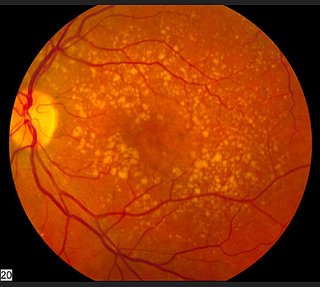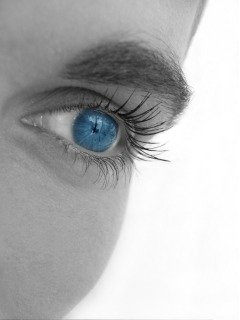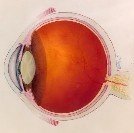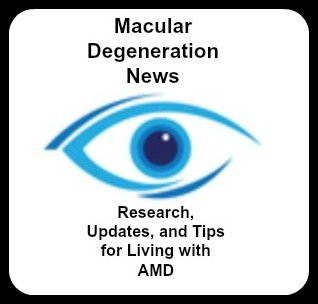Drusen - What Are They?
| There are two main types of drusen in the eye - optic nerve and macular - they are two very different conditions. Macular drusen can be one of the earliest symptoms of macular degeneration. What are they and what do they mean for your vision? |
A Possible Sign of Macular Degeneration
They are simply small yellow or white deposits of lipid (a fatty compound)and calcium that build up in the Bruch's membrane of the eye. The Bruch's membrane is a layer of tissue underneath the retina. The other two important layers are the retinal pigment epithelium (RPE) and the the choroid layer, filled with blood vessels. The job of these three layers of tissue is to bring oxygen and nutrients to the rod and cone cells and remove built up waste products.
When this transportation system gets clogged up and when there is any interference is this system - the rod and cone cells don't get the nourishment they need and can't get rid of the built up waste products. The cone and rod cells then begin to degenerate or die.
My husband, who has a strong family history , went for his yearly eye exam this week, and we wanted to know if any of these little, yellow deposits had developed in the past year. Thankfully, not yet.
Well, why is this important to know? And if I have some of these deposits should I be concerned? It may depend on what type you have.
There are two main types - "hard" and "soft."
Hard Drusen
This type of deposit is the less harmful form and becomes more common as we age. They are characterized by:
round shape
distinct, well defined borders
and are quite small.
They are:
√ very common with age and are
√ very often seen in those 40 and older
√ not an indication of the development of macular degeneration
√ may develop into the soft kind
√ made up of lipids and calcium
Soft Drusen
This type is considered to be an early indicator of macular degeneration and that the process of degeneration of the macula has started. However, there are some people with this type that do not develop macular degeneration. The soft form are characterized by:
pale yellow
ill-defined borders
larger than the hard form
vary in size and shape.
Soft Deposits:
√ Are more often associated with loss of vision
√ May cause the retinal pigment epithelium (RPE) to separate from the other retinal layers. (
If you have a family history of macular degeneration it is especially important to know if you are forming these deposits.
Once they have been detected in your eye exam, it is time to take note and make some changes in your diet and lifestyle. But don't wait for these symptoms . It is much easier to try to prevent macular degeneration than it is to try to reverse it.
To read more about what actions you can take click here: Macular Degeneration Prevention
Number of Drusen & Stage of AMD
Several small drusen or a few medium-sized drusen is a sign of early AMD and many medium-sized drusen or one or more large drusen indicates intermediate AMD. Advanced AMD is noted by several medium size to large size drusen.
According to James C. Folk, M.D., the author of Protect Your Sight: How to Save Your Vision in the Epidemic of Age-Related Macular Degeneration, "In general, eyes with more drusen have a worse prognosis than eyes with fewer drusen."
The more drusen you have the greater chance you have of developing wet macular degneration - the more severe kind of AMD.
"Large numbers of drusen or large confluent drusen are also associated with a significantly increased risk of developing choroidal neovascularization, characteristic of the exudative (wet) form of AMD."
Invest. Ophthalmol. Vis. Sci. October 2003 vol. 44 no. 10 4481-4488
Size Matters
The size of the drusen is an important prognostic factor for this retinal condition as well. Those with larger drusen are more apt to experience leaky blood vessels, or wet macular degeneration which causes more vision loss than dry macular degeneration.
Role in Disease Progression
The detection of macular drusen can also identify those who are at risk for developing AMD. "Drusen within the macula are a significant risk factor for the development of AMD."
Investigative Ophthalmology and Visual Science October 2003 vol. 44 no. 10 4481-4488
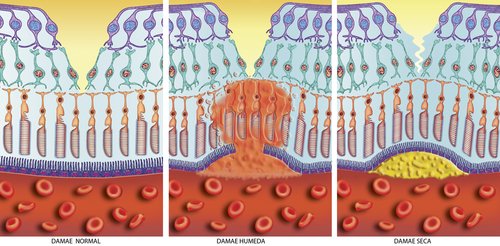
Healthy Retina Wet AMD Drusen
Although these yellow spots don't cause macular degeneration, they can play a role in the progression of this eye disease.
"Retinal cells overlying both soft and hard drusen exhibit structural and molecular abnormalities indicative of photoreceptor degeneration and Müller glial activation. These abnormalities resemble the degenerative effects common to many forms of retinal degeneration, but are confined to areas directly overlying drusen. This suggests that photoreceptor cell function is compromised as a consequence of drusen formation."
Investigative Ophthalmology and Visual Science October 2003 vol. 44 no. 10 4481-4488
Go back to Dry Macular Degeneration
Return to WebRN Macular Degeneration Home Page
√ Prevention of Macular Degeneration?
√ Tips for Daily Living?
√ Food Suggestions for a Macular Degeneration Diet?
√ Ideas on Visual Aids to Maximize your Sight?
If you said "yes" to any of the above, sign up for the monthly Macular Degeneration News.
